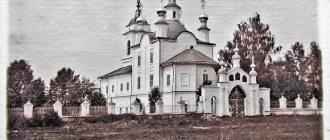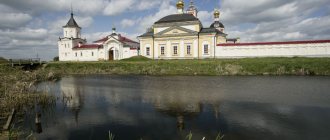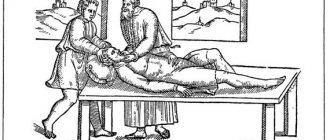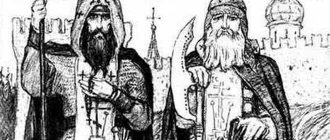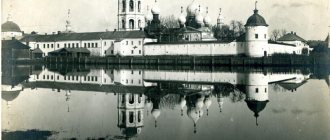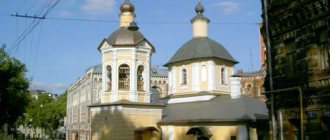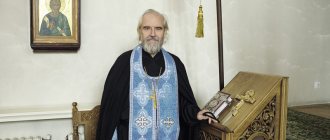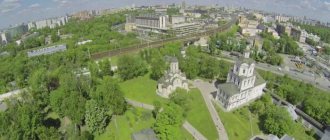Miracles performed by the monks
Over all these many years of veneration, the saints have performed many miracles. People tell many stories in which salvation and blessing were present.
Here is one of the stories about a group of travelers who walked from Krondstat to Oranienbaum. It was cold autumn outside. Ice was already on the river, but it was so fragile that it could hardly support people. After walking just a few meters, people began to fall into the water one after another. There was no chance of salvation.
One of the people, seeing how his comrades were suffering from powerlessness, and realizing that he could not help, began fervently praying to Sergius and Herman of Valaam, asking for help in salvation. He promised the righteous, if saved, to light a candle for them in the temple and devote his entire life to service, becoming a monk.
The saints heard his prayers and helped people. They all escaped and made it to the shore. Upon arrival at the place, the man kept his word and went to the temple to light the promised candles. A year later he took monastic vows.
There are many such stories. In fact, you don’t have to go to Karelia to pray to Saints Sergius and Herman. Quite sincerely and wholeheartedly prays in front of their Icon at home or in the Temple. As the priests say, if faith is present in the heart, and prayer is read not with words, but with the soul, then salvation will definitely occur. The main thing is to believe in a miracle and then it will definitely happen.
Prayer to Sergius and Herman of Valaam
O venerable, God-bearing, blessed fathers Sergius and Herman, spectators of the glory of God in the Heavenly Kingdom! Do not despise us sinners in our needs and sorrows, but hasten those who come running to you to help: accept sighs and tears, and heed our humble prayer. Standing before the Heavenly King, for blessedness, pray to His goodness, to be generous with the place of your settlement and to send down an abundance of earthly blessings to every city and country: To our Most Pious Great Empress, GRAND DUCHESS MARIA VLADIMIROVNA, to grant victory and victory to her enemies and to preserve HER House in peace and silence: Confirm us all in faith and virtue, and always deliver us from sinful lusts and from the attacks of visible and invisible enemies: to protect the offended, to heal the sick, to free us from the torment of evil spirits, to preserve those floating at sea, to help those who travel, and to assist every faithful person in their needs: For of Him we are all creation, and of Him is the Kingdom, and the power, and the glory forever and ever. Amen.
The Lord is always with you!
The best article for you, go to: Holy Martyrs Marcian and Martyrius
Watch another video about Saints Sergius and Herman of Valaam:
Veneration of the Reverends
It has so happened since ancient times that St. Sergius and Herman of Valaam wonderworkers are greatly revered.
- This began within the Novgorod diocese. Evidence of such veneration is their presence in the Cathedral of Novgorod Saints.
- They are also mentioned in the service, which was compiled in the 18th century.
- According to some chronicles, it can be argued that the discovery of the relics of Sergius and Herman of Valaam took place around the 60s, and it was during this period that the beginning of popular veneration of the departed righteous people began.
- In 1755, a cathedral church built of wood appeared on the site destroyed by the Swedes. It was equipped in honor of the founding fathers of the monastery, Sergius and Herman of Valaam. Several decades later, the service was compiled.
Days of blessed memory of veneration are September 24th. On these days, services are read annually in honor of the holy wonderworkers.
COMPLETE LIVES OF THE REVERENDS SERGIUS AND HERMAN, THE VALAAM WONDERWORKERS
The founders of the Spaso-Preobrazhensky Valaam Monastery, Reverends Sergius and German, according to church tradition, were Greek monks who came to the possessions of Veliky Novgorod in the 10th century along with the first Orthodox missionaries. Historical information about the founders of the Valaam Monastery is scarce. Often during enemy invasions (XII, XVII centuries) the monastery experienced devastation, and monastic service was interrupted here for many decades. During the invasions, church monuments and monastic shrines were destroyed, and the richest monastery libraries and manuscript repositories were burned and looted more than once. July 11 - memory of Saints Sergius and Herman, Valaam wonderworkers
The life of Saints Sergius and Herman of Valaam has not reached us either. In the 16th century, many historical documents were already lost, as evidenced by the ancient synodikon of the Valaam Monastery, which after the destruction of the monastery in 1611 was kept in the Staraya Ladoga Vasilievsky Monastery. This synodikon is the only historical document written on Valaam, which reflects genuine knowledge about the founders of the monastery. In the synodikon, the list of abbots mentions St. Sergius and Herman.
Church tradition and ancient chronicle monuments became evidence of the monastic feat of the saints. The meaning of the monastic life of the Monks Sergius and Herman was to enlighten the pagan Karelian tribes with the light of Christ, to establish Orthodoxy in the North of Rus', to found a monastic monastery, which became a stronghold of Orthodoxy in the early centuries of Christian enlightenment. Ancient Novgorod chronicles report the discovery of the relics of St. Sergius and Herman and their transfer to Novgorod during the Swedish invasion in 1163−64.
It was then that the local glorification of the founders of the Valaam monastery took place and the beginning of the church veneration of Saints Sergius and Herman within the Novgorod diocese was laid. Evidence of their church veneration is their presence in the Cathedral of the Novgorod Saints, mentions in the service “To All Russian Saints”, compiled in the 18th century, as well as drawings and icon painting from the 18th century.
At the beginning of the 18th century, icons of Saints Sergius and Herman were known. Reminders of the lost lives of the saints are found in numerous copies of the “Valaam Conversation,” a monument of church journalism of the 16th-17th centuries. The beginning of the “Conversations” is undoubtedly an excerpt from the September Menaion, which tells about the transfer of the relics of the Monks Sergius and Herman (Karelian wonderworkers) from Novgorod to the Monastery of the All-Merciful Savior after the military danger had subsided, apparently in 1182, which is confirmed by the Novgorod chronicles sources. The original place of the exploits of Saints Sergius and Herman is indicated on the Holy Island. This is what the legend says, known under Abbot Ephraim in the second half of the 18th century. This fact is also confirmed by the Swedish atlas, in which on the map of the island of Valaam the Holy Island is called Vanho Valamo - Old Valaam, and a cross is indicated on this island.
The extremely wide distribution of the “Valaam Conversation,” known in many copies of the 16th, 17th, and 18th centuries, testifies to the high spiritual authority of the founders of the Valaam monastery, since it was through their spiritual mouth that the position of the non-covetous in the well-known church polemics of the 16th century was stated.
In 1611, the monastery was destroyed by the Swedes, and Swedish colonists lived on the island. In 1685, during the reign of the Grand Dukes John Alekseevich and Peter Alekseevich, the Swedes wanted to dig up the relics of the saints and abuse them, but the Lord, through the prayers of the saints, soon sent them a great illness and weakened limbs, so they were afraid and built a chapel over their relics.
July 11 - memory of the Monks Sergius and Herman, Valaam wonderworkers. In 1755, Abbot Ephraim built a new wooden cathedral church, in which there was a chapel of St. Sergius and Herman. The traveler, captain Yakov Yakovlevich Mordvinov describes the monastery itself as follows: “The monastery was built on a stone mountain, the churches, the bell tower and the fence are wooden. And a plan was taken for the entire monastery, and on the plan it is indicated: Cathedral Church of the Transfiguration of the Lord, in it there are chapels: on the south side - the holy apostles Peter and Paul, on the north - the holy apostle John the Theologian, on the top from the south of the holy apostle Andrew the First-Called, on the north - righteous saints Zacharias and Elizabeth, below on the south side are the venerable fathers Sergius and Herman, Valaam wonderworkers, where are the relics of St. under a bushel, and on top there are crayfish, and their picturesque images are placed on the crayfish.”
By June 28, 1789, the new cathedral church of St. Sergius and Herman, Valaam wonderworkers, was consecrated by treasurer Innocent and the brethren, where their relics rest in secret. In 1817, Archimandrite Hilarion of the Konevsky Monastery compiled a service to St. Sergius and Herman, the Valaam wonderworkers, and published it in the Synodal Printing House with an instructive word attached in their memory.
In 1819, on October 20, the Holy Synod prescribed all-Russian veneration of the Valaam saints and determined the days of church celebration of their memory - June 28/July 11 and September 11/24.
The relics of Saints Sergius and Herman still rest hidden in the Transfiguration Cathedral of the Valaam Monastery. Evidence of the gracious prayerful help of the saints is the numerous miracles revealed through the faith of those asking and praying.
The founders of the monastery, the Monks Sergius and Herman, the Valaam wonderworkers, did not leave us their lives, which undoubtedly existed; only brief mentions have been preserved in chronicles and ancient manuscripts. But Saints Sergius and Herman never left their brotherhood. They continue to testify for a thousand years to their invisible presence, protecting the Valaam monastery with their prayerful intercession.
I. Historical information about the saints
The date of establishment of the Valaam Monastery is still unknown.
“A short story about the creation of the most honorable monastery of the Divine Transfiguration of the Lord God our Savior Jesus Christ on Valaam.”
The founders of the Spaso-Preobrazhensky Valaam Monastery,
Reverends Sergius and German
, according to church tradition, were Greek monks who came to the possessions of Veliky Novgorod in the 10th century along with the first Orthodox missionaries. Historical information about the founders of the Valaam Monastery is scarce. More than once during enemy invasions (XII, XVII centuries) the monastery experienced devastation, and monastic service was interrupted here for many decades. During the invasions, church monuments and monastic shrines were destroyed, and the richest monastery libraries and manuscript repositories were burned and looted more than once. The life of Saints Sergius and Herman of Valaam has also been lost. In the 16th century, many historical documents were already lost, as evidenced by the ancient synodikon of the Valaam Monastery, which after the destruction of the monastery in 1611 was kept in the Staraya Ladoga Vasilievsky Monastery. This synodikon is the only historical document written on Valaam, which reflects genuine knowledge about the founders of the monastery. In the synodikon, in the list of abbots, the Monks Sergius and Herman are mentioned.
Church tradition and ancient chronicle monuments became evidence of the monastic feat of the Saints. The meaning of the monastic life of the Monks Sergius and Herman was to enlighten the pagan Karelian tribes with the light of Christ, to establish Orthodoxy in the North of Rus', to found a monastic monastery, which became a stronghold of Orthodoxy in the early centuries of Christian enlightenment. Ancient Novgorod chronicles report the discovery of the relics of Saints Sergius and Herman and their transfer to Novgorod during the Swedish invasion in 1163-1164.
In the summer of 1163. About Archbishop John. I installed Archbishop John the First for Veliky Novugrad, and before there were bishops. That same summer, the relics of our venerable fathers Sergius and Herman of Valamsk, Novgorod wonderworkers under Archbishop John of Novgorod, were found and transferred...
It was then that the local glorification of the founders of the Valaam monastery took place and the beginning of the church veneration of Saints Sergius and Herman was laid within the Novgorod diocese.
Evidence of their church veneration is their presence in the Cathedral of the Novgorod Saints, mentions in the service “To All Russian Saints”, compiled in the 18th century, as well as drawings and icon painting from the 18th century. The text of the original reads: “Sergius is gray-haired in the likeness of Alexander Svirsky, the monk’s robe, the schema on his shoulders.” Herman is gray-haired, his brada shorter than Blaasis’s, the monk’s vestments, the schema on his shoulders.” “Sergius is gray-haired, like Alexandra Svirsky’s brada, the monk’s robe, on the shoulders of a schema. Herman is gray-haired, like Kirill Beloezersky’s brada, a venerable robe, with a schema on his shoulders.”
At the beginning of the 18th century, icons of Saints Sergius and Herman were known. A reminder of the lost lives of the Saints is found in numerous copies of the “Valaam Conversation,” a monument of church journalism of the 16th-17th centuries. The beginning of the “Conversations” is undoubtedly an excerpt from the September Menaion, which tells about the transfer of the relics of St. Sergius and Herman (Karelian wonderworkers) from Novgorod to the Monastery of the All-Merciful Savior after the military danger had subsided, apparently in 1182, which is confirmed by the Novgorod chronicle sources. The original place of the exploits of Saints Sergius and Herman is indicated on the Holy Island. So says the legend known under Abbot Ephraim in the second half of the 18th century.
This fact is also confirmed by the Swedish atlas, in which on the map of the island of Valaam the Holy Island is called Vanho Valamo - Old Valaam, and a cross is indicated on this island.
The oldest monastery in Novgorod land
“Until the 18th century, the monastery was devastated more than once during military clashes between Veliky Novgorod and its western neighbors. As a result, the handwritten wealth of the monastery was lost and even the lives of its founders, the Venerable Sergius and Herman of Valaam, were not preserved... This makes it very difficult to study the early history of the famous monastery and determine the exact date of its foundation...”
In the letter of the Novgorod Metropolitan Varlaam, dated May 27, 1592, some rules of the Valaam hostel are set out: “To live according to the monastic order, decorously, peacefully, serenely, according to paternal tradition and according to the law of the Venerable Valaam founders Sergius and Herman - a hostel. The law and principles laid down in the Valaam Monastery from time immemorial must not be destroyed, but preserved with all reverence. To live in harmony with all the brethren and servants together, with one mind and among themselves in obedience. To do the monastery's things according to the advice, from the gathering of all the brethren; Without a fraternal council, neither the elder nor the servant should act. The community should be observed as before: clothes and shoes should be given in the old way, from the monastery treasury, to both the brethren and the servants. The treasurer in every way: income and expenses, count in truth according to the lists.”
The extremely wide distribution of the “Valaam Conversation,” known in many copies of the 16th, 17th, and 18th centuries, testifies to the high spiritual authority of the founders of the Valaam monastery, since it was through their spiritual mouth that the position of the non-covetous in the well-known church polemics of the 16th century was stated.
In 1819, on October 20, the Holy Synod prescribed all-Russian veneration of the saints of Valaam and determined the days of church celebration of their memory as June 28 (July 11, new style) and September 11 (September 24, new style).
Russian Orthodox Church
The founders of the Spaso-Preobrazhensky Valaam Monastery, Reverends Sergius and German, according to church tradition, were Greek monks who came to the possessions of Veliky Novgorod in the 10th century along with the first Orthodox missionaries. Historical information about the founders of the Valaam Monastery is scarce. Often during enemy invasions (XII, XVII centuries) the monastery experienced devastation, and monastic service was interrupted here for many decades. During the invasions, church monuments and monastic shrines were destroyed, and the richest monastery libraries and manuscript repositories were burned and looted more than once.
The life of Saints Sergius and Herman of Valaam has not reached us either. In the 16th century, many historical documents were already lost, as evidenced by the ancient synodikon of the Valaam Monastery, which after the destruction of the monastery in 1611 was kept in the Staraya Ladoga Vasilievsky Monastery. This synodikon is the only historical document written on Valaam, which reflects genuine knowledge about the founders of the monastery. In the synodikon, the list of abbots mentions St. Sergius and Herman.
Church tradition and ancient chronicle monuments became evidence of the monastic feat of the Saints. The meaning of the monastic life of the Monks Sergius and Herman was to enlighten the pagan Karelian tribes with the light of Christ, to establish Orthodoxy in the North of Rus', to found a monastic monastery, which became a stronghold of Orthodoxy in the early centuries of Christian enlightenment. Ancient Novgorod chronicles report the discovery of the relics of St. Sergius and Herman and their transfer to Novgorod during the Swedish invasion in 1163-64.
It was then that the local glorification of the founders of the Valaam monastery took place and the beginning of the church veneration of Saints Sergius and Herman within the Novgorod diocese was laid. Evidence of their church veneration is their presence in the Cathedral of the Novgorod Saints, mentions in the service “To All Russian Saints”, compiled in the 18th century, as well as drawings and icon painting from the 18th century.
At the beginning of the 18th century, icons of Saints Sergius and Herman were known. A reminder of the lost lives of the Saints is found in numerous copies of the “Valaam Conversation,” a monument of church journalism of the 16th-17th centuries. The beginning of the “Conversations” is undoubtedly an excerpt from the September Menaion, which tells about the transfer of the relics of the Monks Sergius and Herman (Karelian wonderworkers) from Novgorod to the Monastery of the All-Merciful Savior after the military danger had subsided, apparently in 1182, which is confirmed by the Novgorod chronicles sources. The original place of the exploits of Saints Sergius and Herman is indicated on the Holy Island. This is what the legend says, known under Abbot Ephraim in the second half of the 18th century. This fact is also confirmed by the Swedish atlas, in which on the map of the island of Valaam the Holy Island is called Vanho Valamo - Old Valaam, and a cross is indicated on this island.
The extremely wide distribution of the “Valaam Conversation,” known in many copies of the 16th, 17th, and 18th centuries, testifies to the high spiritual authority of the founders of the Valaam monastery, since it was through their spiritual mouth that the position of the non-covetous in the well-known church polemics of the 16th century was stated.
In 1611, the monastery was destroyed by the Swedes, and Swedish colonists lived on the island. In 1685, during the reign of the Grand Dukes John Alekseevich and Peter Alekseevich, the Swedes wanted to dig up the relics of the saints and abuse them, but the Lord, through the prayers of the saints, soon sent them a great illness and weakened limbs, so they were afraid and built a chapel over their relics.
In 1755, Abbot Ephraim built a new wooden cathedral church, in which there was a chapel of St. Sergius and Herman. The traveler, captain Yakov Yakovlevich Mordvinov describes the monastery itself as follows: “The monastery was built on a stone mountain, the churches, the bell tower and the fence are wooden. And a plan was taken for the entire monastery, and on the plan it is indicated: Cathedral Church of the Transfiguration of the Lord, in it there are chapels: on the south side - the holy apostles Peter and Paul, on the north - the holy apostle John the Theologian, on the top from the south of the holy apostle Andrew the First-Called, on the north the saints righteous Zechariah and Elizabeth, below on the south side are the venerable fathers Sergius and Herman, Valaam wonderworkers, where the relics of St. under a bushel, and on top there are crayfish, and their picturesque images are placed on the crayfish.”
By June 28, 1789, the new cathedral church of the Venerable Sergius and Herman of Valaam wonderworkers was consecrated by the treasurer Innocent and the brethren, where their relics rest in secret. In 1817, Archimandrite Hilarion of the Konevsky Monastery compiled a service to St. Sergius and Herman, the Valaam wonderworkers, and published it in the Synodal Printing House with an instructive word attached in their memory.
In 1819, on October 20, the Holy Synod prescribed all-Russian veneration of the Valaam saints and determined the days of church celebration of their memory as June 28/July 11 and September 11/24.
The relics of Saints Sergius and Herman still rest hidden in the Transfiguration Cathedral of the Valaam Monastery. Evidence of the blessed prayer help of the Saints is the numerous miracles revealed through the faith of those asking and praying.
The founders of the monastery, the Venerable Sergius and Herman, the Valaam wonderworkers, did not leave us their life, which undoubtedly existed; only brief mentions have been preserved in chronicles and ancient manuscripts. But Saints Sergius and Herman never left their brotherhood. They continue to testify for a thousand years to their invisible presence, protecting the Valaam monastery with their prayerful intercession.
Based on materials from the official website of the Valaam Monastery.
